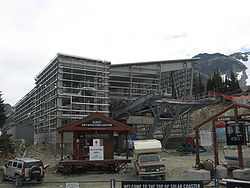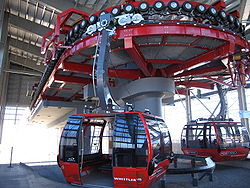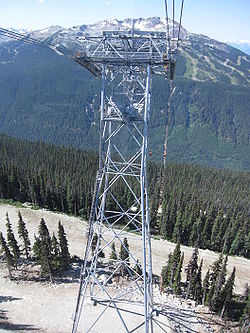
Peak 2 Peak Gondola
Encyclopedia

Gondola lift
A gondola lift is a type of aerial lift, normally called a cable car, which is supported and propelled by cables from above. It consists of a loop of steel cable that is strung between two stations, sometimes over intermediate supporting towers. The cable is driven by a bullwheel in a terminal,...
located in Whistler, British Columbia
Whistler, British Columbia
Whistler is a Canadian resort town in the southern Pacific Ranges of the Coast Mountains in the province of British Columbia, Canada, approximately north of Vancouver...
that links Whistler Mountain
Whistler Mountain
Whistler Mountain is a mountain in the Fitzsimmons Range of the Pacific Ranges of the Coast Mountains, located on the northwestern edge of Garibaldi Provincial Park. It is the location of the Whistler-Blackcomb ski resort and the town of Whistler, British Columbia.The original name of the mountain...
's Roundhouse Lodge with Blackcomb Mountain's Rendezvous Restaurant. It is the first lift to join the two side-by-side mountains. It holds world records for the longest free span between ropeway towers—3.03 kilometres (1.88 miles) and highest point above the ground—436 metres (1,430 feet.) (A temporary aerial tramway
Feldmoos-Chli-Titlis Aerial Tramway
Feldmoos-Chli-Titlis Aerial Tramway was an aerial tramway in Switzerland. It was built in 1979 by the Swiss company Habegger between Feldmoos and Chli Titlis for the erection of a communication facility on Chli Titlis. The aerial tramway was used for transporting goods with a weight up to 3.8 tons...
in Switzerland used between 1979 and 1986 had larger span.) The Peak 2 Peak Gondola was built by the Doppelmayr Garaventa Group in 2007 and 2008 at a cost of CDN$51 million. The Peak 2 Peak Gondola is the first Doppelmayr
Doppelmayr
The Doppelmayr Garaventa Group is an Austrian-Swiss company that manufactures chairlifts, cable cars, gondolas, surface tows for ski and amusement parks as well as urban people movers and material handling systems. To date, Doppelmayr and Garaventa have produced over 13,700 installations in 78...
"3S" tri-cable lift in North America; there are four similar but smaller lifts in Europe which were built in 1991, 1994, 2002, 2004 and 2010 in Switzerland, Austria, France and Germany. Whistler-Blackcomb has touted the gondola as an iconic attraction and uses it to transport skiers in the winter months as well as sightseers year round.
History and planning
Whistler Mountain was opened by the Garibaldi Lift Company in 1965 and Blackcomb opened under separate ownership in 1980. It wasn’t until 1997 when IntrawestIntrawest
Intrawest ULC is a developer and operator of destination resorts and a luxury adventure travel company. The company was founded in 1976 as a privately funded real estate development company...
, the owner of Blackcomb Mountain, bought Whistler Mountain and brought both mountains together on a single lift ticket
Lift ticket
A Lift ticket is an identifier usually attached to a skier's outerwear that indicates they have paid and can ride on the ski lift up a mountain to ski....
. Ever since, many skiers wanted a way to be able to ski both mountains in one day without having to ski down to the village and ride multiple lifts to get back to the alpine. In 1997, Whistler-Blackcomb's Director of Mountain Operations, Hugh Smythe, and Paul Mathews, president of Ecosign Mountain Resort Planners, took a trip to Zermatt
Zermatt
Zermatt is a municipality in the district of Visp in the German-speaking section of the canton of Valais in Switzerland. It has a population of about 5,800 inhabitants....
, Switzerland. After seeing the number of lifts connecting resorts around the Matterhorn
Matterhorn
The Matterhorn , Monte Cervino or Mont Cervin , is a mountain in the Pennine Alps on the border between Switzerland and Italy. Its summit is 4,478 metres high, making it one of the highest peaks in the Alps. The four steep faces, rising above the surrounding glaciers, face the four compass points...
, they got the idea of connecting Whistler and Blackcomb Mountains with a ropeway.
A number of problems prevented a connection for years. Fitzsimmons Creek and the steep faces on either side were unsuitable as ski terrain and are protected land. A traditional chairlift or gondola would have had to go all the way down one mountain, across Fitzsimmons Creek, and up the other side, resulting in a long lift ride and environmental impacts. A gondola that could cross the valley without going to the bottom was the best option. Whistler-Blackcomb had to consider the extremely high cost of building such a lift. The resort conducted research that indicated 92% of winter visitors and 86% of summer visitors would use the gondola at least once. HSBC Bank Canada
HSBC Bank Canada
HSBC Bank Canada, formerly the Hongkong Bank of Canada , is a bank in Canada that is part of British banking giant HSBC - one of the largest banking groups in the world. HSBC Canada is the seventh largest bank in Canada, with offices in every province except Prince Edward Island, and is the...
and Scotia Capital
Scotiabank
The Bank of Nova Scotia , commonly known as Scotiabank , is the third largest bank in Canada by deposits and market capitalization. It serves some 18.6 million customers in more than 50 countries around the world and offers a broad range of products and services including personal, commercial,...
agreed to provide Intrawest with financing for the project, allowing it to move forward.
Intrawest announced the gondola project to employees and the Municipality of Whistler’s Council on September 19, 2005 and held a community open house shortly thereafter. At the time, construction was expected to start in the summer of 2006 and continue for 2 years for an opening for the 2007-2008 ski season. On March 30, 2006, it was announced that construction would be delayed by one year. Whistler Blackcomb announced on April 17, 2007 that groundbreaking would occur in May 2007.
Construction


80 workers from Whistler Blackcomb, Doppelmayr Garaventa, and Timberline Construction worked throughout the summer of 2007. Work completed that summer included the relocation of the top terminals of the Solar Coaster Express and Catskinner chairlifts on Blackcomb, excavation of both terminal locations, foundations for both terminals, foundations for all four intermediate towers, and steel erection of towers 2 and 3. Construction stopped for the winter in November 2007.
During the winter, the remaining two gondola towers and each terminal’s machinery were built at the Garaventa factory in Goldau, Switzerland and the Doppelmayr factories in Wolfurt, Austria and St. Jerome, Quebec. Fatzer AG manufactured the four track cables and haul rope that would suspend the gondola cabins. The five spools of cable left Europe by ship on April 10, 2008.
By the time construction started again in the spring of 2008, ten feet of snow still covered the mountains and concrete had to be transported up the mountain by helicopter. Towers 4 and 1 were completed in early spring using mobile cranes.
The five cables arrived in the Port of Vancouver, Washington, USA on June 9 and were shipped to Whistler via train, arriving on June 16. Vancouver, Washington was used because it owns the largest mobile harbor crane on the West Coast of North America. To handle the 90-tonne reels, a German-made Goldhofer heavy-haulage trailer and tractor made its way from Montreal, QC to Whistler to take care of the transport from the train yard up the mountain. The Goldhofer trailer, which has four sections with six axles each. Each axle has eight wheels. The trailer also features a hydraulic sliding system, which enabled the reels to be unloaded from the railcars in Whistler without a crane. Since there is no crane to lift each reel onto the truck, this trailer features sliding steel plates that essentially scoop the load from the train and set it onto the trailer deck. The five cables were trucked up Blackcomb Mountain for pulling across the valley starting June 19. Their entire 18000 miles (28,968.1 km) journey from Switzerland to the top of Blackcomb Mountain was coordinated by OmniTrans Corporation.
Each track cable was winched down Blackcomb Mountain to the valley floor, then up Whistler Mountain. While the cables were pulled for twelve straight weeks, terminal construction continued with the gondola machinery being mounted on concrete foundations.
The drive terminal on Whistler Mountain had the gondola’s motors installed in an underground vault. After the gondola machinery was installed, steel enclosures were constructed and covered with a blue, translucent material.
On August 29 and 30, the two ends of the haul rope were spliced together in a 220 feet (67.1 m) braid to form a continuous loop that could pull the cabins. The splice was performed by Norm Duke of Wyoming, who is one of only a few splicers in North America. The splicing process took 14 workers from Whistler-Blackcomb and Doppelmayr Garaventa over 15 hours to complete. The 28 sky cabins arrived in Whistler starting on August 26. The first twelve cabins crossed the span on September 19, 2008 with a single Doppelmayr engineer, Mathias Zudrell, aboard. The remaining cabins were put on line and the system underwent extensive testing until its Grand Opening on December 12, 2008. The grand opening ceremony featured Steve Podborski
Steve Podborski
Stephen Gregory Podborski, is a Canadian former World Cup and Olympic downhill ski racer with Ukrainian ancestry.-Racing career:...
as emcee and Red Bull
Red Bull
Red Bull is an energy drink sold by the Austrian Red Bull GmbH, created in 1987 by the Austrian entrepreneur Dietrich Mateschitz. In terms of market share, Red Bull is the most popular energy drink in the world, with 3 billion cans sold each year. Dietrich Mateschitz was inspired by an already...
Air Force members BASE Jumping from the middle of the gondola.
Criticism

When construction was announced, it was claimed that no trees would be cut under the gondola's lift line, resulting the smallest ground disturbance of any lift project in Whistler Blackcomb's history. When it came time to pull the ropes for the gondola, a swath of trees was cut under the entire lift.
In May 2007, Whistler-Blackcomb announced the naming rights to the gondola were for sale for an undisclosed price. Presumably they were never sold because the gondola has retained the Peak 2 Peak name.
Statistics
- Length: 4.4 km/2.73 mi
- Capacity: 4,100 people per hour
- Line Speed: 7.5 metres per second
- Ride Time: 11 minutes
Cables
The cables were manufactured by Fatzer AG, a Swiss company that develops, manufactures and markets wire ropes worldwide. The Peak 2 Peak cables include four stationary track ropes, two in each direction, which act like railroad tracks for the cabins. Each track rope weighs approximately 90 metric tonnes. There is a single haul rope which moves in a continuous loop and pulls the cabins. This cable weighs more than 80 metric tonnes. There are a total of 26.5 kilometres (86,942.3 ft) of cable on the Peak 2 Peak Gondola.Terminals
The Peak 2 Peak Gondola terminal buildings are the two largest lift terminals in the world.To create the concrete footings, platforms, masts, and columns, 4000 cubic metres (5,231.8 cu yd) of concrete had to be trucked and helicoptered up the mountains. The 12000 ft2 Whistler terminal, which houses the drive motors and backup engines in an underground vault is 26 metres (85 feet) wide and 42 metres (138 feet) long and has 228 tonnes of steel. The 14000 square feet (1,300.6 m²) Blackcomb Terminal is 26 metres (85 feet) wide and 48 metres (158 feet) long and contains 279 tonnes of steel. The Blackcomb terminal can house 15 cabins, the Whistler terminal 13 cabins in a cabin parking area when the system is not in use.
Towers

Cabins
The 28 CWA-manufactured gondola cabins hold 28 people each, with 22 seated and 6 standing. 26 of the cabins are painted red while 2 are painted silver and have glass floors.Safety systems
The Peak 2 Peak Gondola has a number of unique safety systems that go above and beyond what a normal ski lift features. The gondola has high wind stability and is designed to operate in winds up to 80 km/h. Whistler-Blackcomb has called the Peak 2 Peak Gondola the most wind tolerant lift on Whistler Blackcomb. Testing at other Doppelmayr 3S installations have measured sustained winds at 120 km/h (75 mph) with no decrease in performance.The lift is powered by an electric motor on Whistler Mountain; however an auxiliary diesel engine can take over in the case of primary engine failure or if there is a power outage. The lift also has a redundant braking system. Both bullwheels have emergency brakes to stop the gondola if there is a primary braking system failure. In addition, each terminal has two sets of tire conveyors, either of which can accelerate and decelerate cabins out of and into the terminals.
In the event of a catastrophic failure, an evacuation can be performed. For cabins that are near the terminals, passengers are lowered down by rope from the cabins. For cabins that are too high off the ground for a rope evacuation, cabins are winched along the track cables to towers 2 and 3 where passengers are then lowered to the ground by rope by Ski Patrol members.
In addition, the gondola is equipped with a state of the art Obstacle Collision Avoidance System
Obstacle Collision Avoidance System
The Obstacle Collision Avoidance System is designed to alert pilots if their aircraft is in immediate danger of flying into an obstacle. OCAS uses a low power ground based radar to provide detection and tracking of an aircraft's proximity to an obstacle such as a power line crossing, telecom...
that uses radar to alert aircraft of the gondola as an obstacle. Strobe lights and loud noises over all radio frequencies are used to alert pilots who come too close to the gondola.
Documentary
The Peak 2 Peak Gondola is also the subject of a Discovery ChannelDiscovery Channel
Discovery Channel is an American satellite and cable specialty channel , founded by John Hendricks and distributed by Discovery Communications. It is a publicly traded company run by CEO David Zaslav...
documentary. Crews began filming the project during groundbreaking in May 2007. The documentary aired at 9 pm on December 23 and at 2 am on December 24, 2009, on Discovery Channel Canada. It was titled "Peak 2 Peak: Building the Worlds Biggest Gondola"

